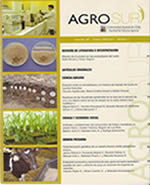Intensive milk production system based on irrigated permanent pastures in the south of Chile. I Productive and reproductive parameters
Main Article Content
Abstract
Previous research (Butendieck et al., 1991) suggested the possibility of achieving 12,360 kg of milk ha-1 from permanent perennial ryegrass-white clover irrigated pastures. To test this hypothesis, 9 ha of 12 years old pastures were subdivided in eighteen paddocks and managed as a closed dairy system with lactating and dry cows. Twenty to 27 Friesian cows were used, 50% autumn calving and 50% spring calving. A rotational grazing leaded by the milking cows and followed by the dry cows was used. Starting in May, and for 90-100 days the cows were kept in the barn, fed with grass-legume silage, hay and concentrate. This was the case for the first two seasons and in the following three seasons eight of the nine hectares were subdivided in half and randomly one half was grazed during the winter and the other half not. The pasture was fertilized at the end of July with 32 kg N, 60 kg P2O5 and 30 kg K2O and an additional 16 kg N in December. Furthermore, 10 tons of decomposed manure ha-1 was applied to 1/3 of the area in March each year. The average milk yield over five seasons was 12,590 kg ha-1 with a stocking rate of 2.3 A.U. As extra-system feed, 124 g of concentrate per kg of milk was given. Reproductive efficiency was 81,3% and the culling rate 24.3%. Grazing managemente of 12,8% in milk production in favor of winter lagged pastures.

